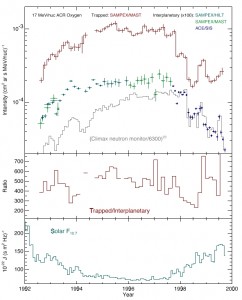Solar Cycle Dependence of the Geomagnetically Trapped Anomalous Cosmic Rays
We now have more than 7 years of trapped ACR data from SAMPEX including the minimum phase of the solar cycle, when the interplanetary ACR are most abundant, and the recent approach to solar maximum. The time dependence of the trapped ACR oxygen intensity is shown in red with 52-day time resolution at the top of the accompanying figure (see below) It is normalized to represent the intensity at a kinetic energy of 17 MeV/nucleon and at L = 2. Also shown at the top are the interplanetary ACR oxygen measurements from SAMPEX (8 to 27 MeV/nucleon) and ACE (7.1 to 29.4 MeV/nucleon) in green and blue, scaled to 17 MeV/nucleon, and the 27-day average scaled Climax neutron monitor rate in gray. The ratio of the trapped to interplanetary ACR intensities are in the middle, and the 27-day average solar 10.7 cm radio flux (F10.7) are below. The solar cycle dependencies of both the trapped and interplanetary ACR are clearly evident. The intensities generally increase during the approach to solar minimum from 1992 to 1995, are relatively steady during the solar minimum period from 1995 to 1997, and decrease during the subsequent approach to solar maximum. These variations are also mirrored in the scaled neutron monitor rate, which generally reflects the solar modulation of higher energy cosmic rays, although the ACR recovered more quickly than the neutron monitor rate prior to solar minimum. The cosmic ray intensities are inversely related to F10.7 which directly reflects the solar activity cycle.
We have calculated lifetimes of trapped particles based on theoretical energy loss in a drift averaged model atmosphere. For 20 MeV/nucleon oxygen at the SAMPEX altitude they vary from a few months at solar minimum conditions (F10.7 = 70) to a few days at solar maximum conditions (F10.7 = 230). During the period of decreasing ACR intensity an intermediate value of F10.7 = 140 may be most appropriate and the corresponding lifetime is near 1 month. These results appear to be generally consistent with the observed trapped ACR loss rates. At altitudes well above those observable by SAMPEX the lifetimes become comparable to the 11-year solar cycle even at solar maximum conditions, so we expect the trapped ACR to be less variable at those altitudes.
These results have been accepted for publication in Geophysical Research Letters.
Contributed by Richard Selesnick, Aerospace Corp.
«Return to the Results page
